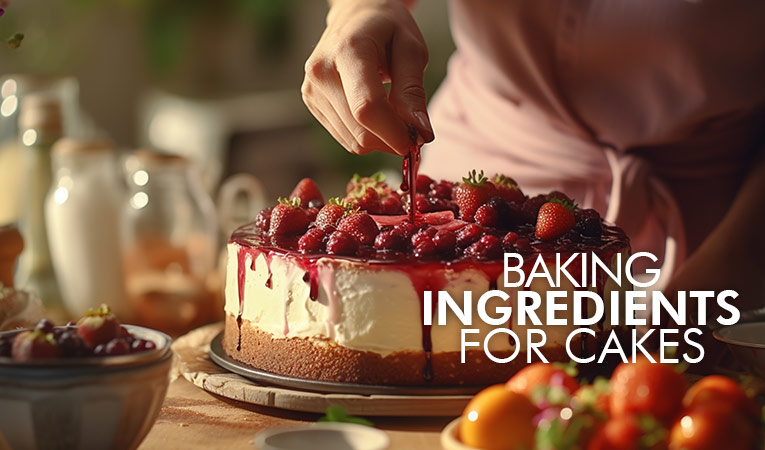Baking a perfect cake requires a harmonious blend of ingredients, each playing a unique role in creating texture, flavor, and structure. Whether you’re just starting your baking journey or you’re a seasoned pro, understanding the key ingredients and how to use them can elevate your cake game. Here’s a comprehensive guide to the essential and advanced ingredients for cakes.
Essential Baking Ingredients for Beginners
- Flour
- Purpose: Provides structure to the cake.
- Types:
- All-Purpose Flour: Great for most cakes, especially dense ones like pound cakes.
- Cake Flour: Contains less protein, resulting in lighter, fluffier cakes.
- Tip: Sift flour for a smoother batter and lighter texture.
- Sugar
- Purpose: Sweetens the cake and helps retain moisture.
- Types:
- Granulated Sugar: Standard for most recipes.
- Brown Sugar: Adds moisture and a caramel-like flavor.
- Powdered Sugar: Used for icings or dusting.
- Tip: Creaming sugar with butter helps aerate the batter.
- Eggs
- Purpose: Bind ingredients, provide structure, and add richness.
- Tip: Use room-temperature eggs for better mixing and consistent results.
- Butter or Oil
- Butter: Adds flavor and helps create a tender crumb.
- Oil: Keeps cakes moist and works well in chocolate or spiced cakes.
- Tip: Use unsalted butter to control the salt content.
- Leavening Agents
- Purpose: Help the cake rise by creating air pockets.
- Types:
- Baking Powder: A combination of acid and base.
- Baking Soda: Requires an acidic ingredient (like buttermilk or vinegar) to activate.
- Tip: Always check the expiration date of leavening agents for effectiveness.
- Liquid
- Purpose: Hydrates dry ingredients and activates gluten.
- Types:
- Milk: Adds moisture and richness.
- Buttermilk or Yogurt: Adds tanginess and softens the cake texture.
- Tip: Substitute part of the liquid with coffee or fruit juice for added flavor.
- Salt
- Purpose: Enhances flavor and balances sweetness.
- Tip: A pinch of salt can make all the difference in flavor depth.
- Vanilla Extract
- Purpose: Adds a warm, sweet aroma and flavor.
- Tip: Use pure vanilla extract or vanilla bean paste for the best results.
Advanced Ingredients for Expert Bakers
- Specialty Flours
- Almond Flour: Adds a nutty flavor and moist texture.
- Gluten-Free Flours: Useful for dietary restrictions.
- Tip: Combine gluten-free flours with xanthan gum to mimic traditional flour’s elasticity.
- Cocoa Powder
- Types:
- Natural Cocoa Powder: Acidic, works with baking soda.
- Dutch-Processed Cocoa Powder: Milder flavor, works with baking powder.
- Tip: Sift cocoa powder to avoid lumps in the batter.
- Types:
- Flavor Enhancers
- Espresso Powder: Intensifies chocolate flavor.
- Zests (Lemon, Orange): Adds a fresh, citrusy note.
- Spices (Cinnamon, Nutmeg, Cardamom): Add complexity and warmth.
- Extracts and Emulsions
- Beyond vanilla, try almond, lemon, or peppermint extracts.
- Emulsions are more concentrated and often better for high-heat baking.
- Dairy Enhancers
- Sour Cream: Adds moisture and richness, especially in dense cakes.
- Heavy Cream: Useful for whipped ganaches or rich batters.
- Stabilizers
- Gelatin: Helps stabilize whipped cream toppings or mousse cakes.
- Cornstarch: Can be mixed with flour to create a tender crumb.
- Natural Sweeteners
- Honey: Adds moisture and a unique flavor.
- Maple Syrup: Pairs well with spiced cakes.
- Tip: Adjust liquid ratios when using liquid sweeteners.
- Nuts and Fruits
- Dried Fruits: Soak in alcohol or juice to keep them plump.
- Nuts: Toast before adding for deeper flavor.
- Fresh Fruits: Use sparingly to avoid excess moisture in the batter.
- Chocolate
- Bittersweet or Semi-Sweet: Best for ganaches and batters.
- White Chocolate: Great for specialty cakes.
- Tip: Chop chocolate finely to ensure even melting.
- Edible Decorations
- Sprinkles, Candied Flowers, and Edible Gold: Perfect for elevating the cake’s presentation.
Pro Tips for Using Ingredients
- Measure Accurately: Baking is a science, so invest in a kitchen scale for precise measurements.
- Temperature Matters: Use room-temperature ingredients unless otherwise specified.
- Quality Ingredients: Always choose the best-quality chocolate, butter, and vanilla for exceptional results.
- Ingredient Substitutions: Experiment cautiously—small changes can significantly impact the cake’s texture and flavor.
Final Thoughts
Whether you’re a beginner working with the basics or an expert experimenting with advanced ingredients, understanding the role of each component is key to baking success. The magic of cake lies not just in the recipe but in how you balance and treat your ingredients.
Happy baking! 🎂

